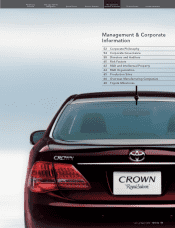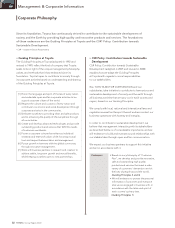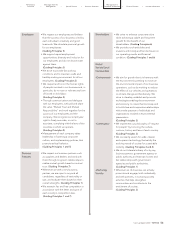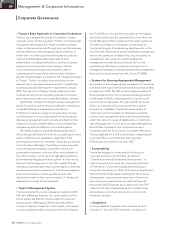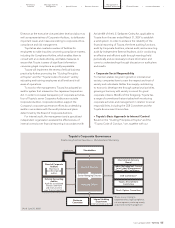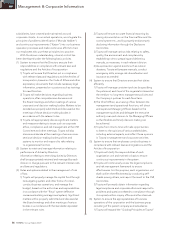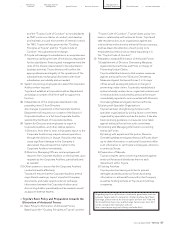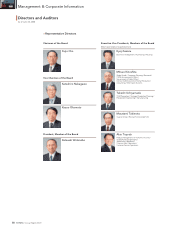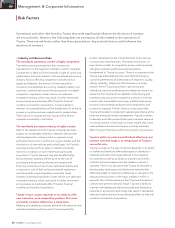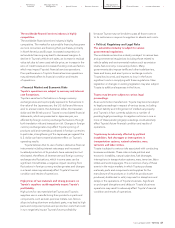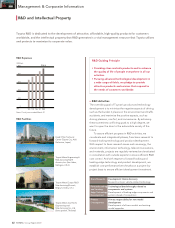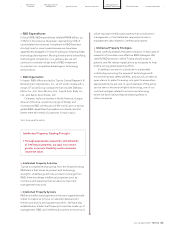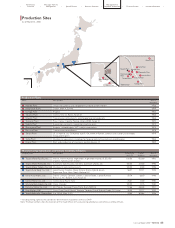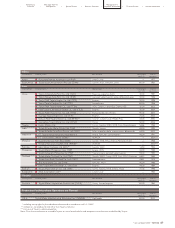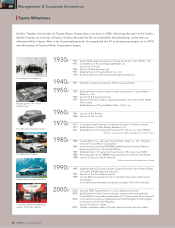Toyota 2008 Annual Report Download - page 63
Download and view the complete annual report
Please find page 63 of the 2008 Toyota annual report below. You can navigate through the pages in the report by either clicking on the pages listed below, or by using the keyword search tool below to find specific information within the annual report.
61
•Annual Report 2008 • TOYOTA
The worldwide financial services industry is highly
competitive.
The worldwide financial services industry is highly
competitive. The market for automobile financing has grown
as more consumers are financing their purchases, primarily
in North America and Europe. Increased competition in
automobile financing may lead to decreased margins. A
decline in Toyota’s vehicle unit sales, an increase in residual
value risk due to lower used vehicle price, an increase in the
ratio of credit losses and increased funding costs are factors
which may impact Toyota’s financial services operations.
Poor performance in Toyota’s financial services operations
may adversely affect its financial condition and results
of operations.
»Financial Market and Economic Risks
Toyota’s operations are subject to currency and interest
rate fluctuations.
Toyota is sensitive to fluctuations in foreign currency
exchange rates and is principally exposed to fluctuations in
the value of the Japanese yen, the U.S. dollar and the euro
and, to a lesser extent, the Australian dollar, the Canadian
dollar and the British pound. Toyota’s consolidated financial
statements, which are presented in Japanese yen, are
affected by foreign currency exchange fluctuations through
both translation risk and transaction risk. Changes in foreign
currency exchange rates may affect Toyota’s pricing of
products sold and materials purchased in foreign currencies.
In particular, strengthening of the Japanese yen against the
U.S. dollar can have a material adverse effect on Toyota’s
operating results.
Toyota believes that its use of certain derivative financial
instruments including interest rate swaps and increased
localized production of its products have reduced, but not
eliminated, the effects of interest rate and foreign currency
exchange rate fluctuations, which in some years can be
significant. Nonetheless, a negative impact resulting from
fluctuations in foreign currency exchange rates and changes
in interest rates may adversely affect Toyota’s financial
condition and results of operations.
High prices of raw materials and strong pressure on
Toyota’s suppliers could negatively impact Toyota’s
profitability.
High prices for raw materials that Toyota and Toyota’s
suppliers use in manufacturing their products or parts and
components, such as steel, precious metals, non-ferrous
alloys including aluminum and plastic parts, may lead to high
parts and component prices and production costs that could
in turn negatively impact Toyota’s future profitability
because Toyota may not be able to pass all those costs on
to its customers or require its suppliers to absorb such costs.
»Political, Regulatory and Legal Risks
The automotive industry is subject to various
governmental regulations.
The worldwide automotive industry is subject to various laws
and governmental regulations including those related to
vehicle safety and environmental matters such as emission
levels, fuel economy, noise and pollution. Many
governments also impose tariffs and other trade barriers,
taxes and levies, and enact price or exchange controls.
Toyota has incurred, and expects to incur in the future,
significant costs in complying with these regulations. New
legislation or changes in existing legislation may also subject
Toyota to additional expenses in the future.
Toyota may become subject to various legal
proceedings.
As an automotive manufacturer, Toyota may become subject
to legal proceedings in respect of various issues, including
product liability and infringement of intellectual property,
and Toyota is in fact currently subject to a number of
pending legal proceedings. A negative outcome in one or
more of these pending legal proceedings could adversely
affect Toyota’s future financial condition and results of
operations.
Toyota may be adversely affected by political
instabilities, fuel shortages or interruptions in
transportation systems, natural calamities, wars,
terrorism and labor strikes.
Toyota is subject to various risks associated with conducting
business worldwide. These risks include political and
economic instability, natural calamities, fuel shortages,
interruptions in transportation systems, wars, terrorism, labor
strikes and work stoppages. The occurrence of any of these
events in the major markets in which Toyota purchases
materials, parts and components and supplies for the
manufacture of its products or in which its products are
produced, distributed or sold, may result in disruptions and
delays in the operations of Toyota’s business. Significant
or prolonged disruptions and delays in Toyota’s business
operations may result to adversely affect Toyota’s financial
condition and results of operations.
Performance Messages from the Management &
•Overview •Management •Special Feature •Business Overview •Corporate Information •Financial Section •Investor Information •


